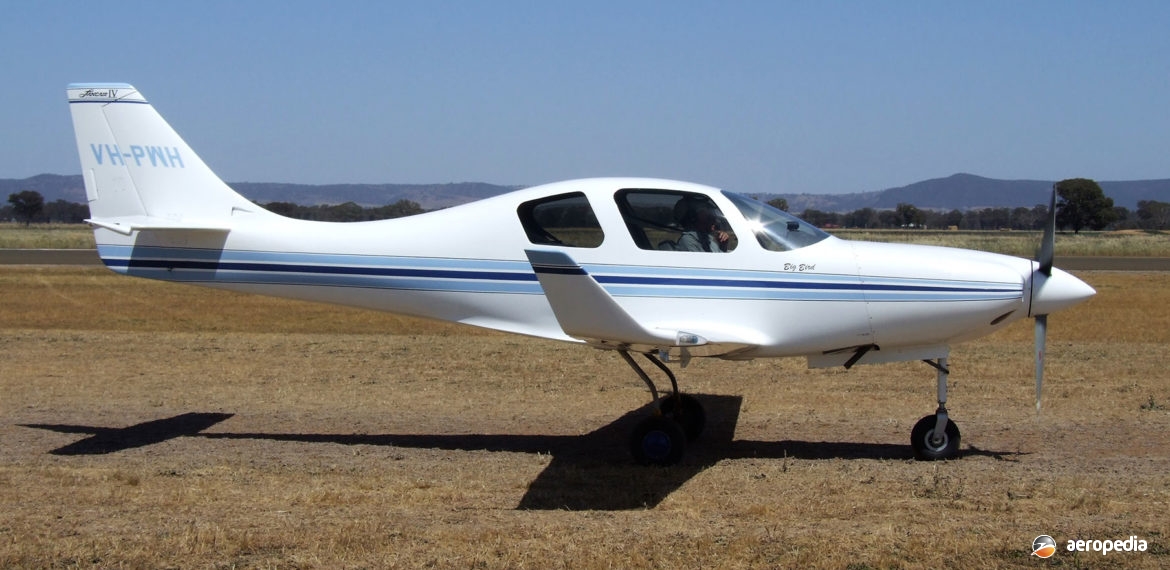Photograph:
Neico Lancair IV VH-PWH (c/n N371) at Cowra, NSW in October 2007 (David C Eyre)
Country of origin:
United States of America
Description:
Four-seat high-performance cabin monoplane
Power Plant:
One 261 kw (350 hp) Teledyne Continental TSIO-550-B1B twin-turbocharged six-cylinder horizontally-opposed air-cooled engine
Specifications:
- Wingspan: 9.19 m (30 ft 2 in)
- Length: 7.62 m (25 ft)
- Height: 2.44 m (8 ft)
- Wing area: 9.10 m² (98 sq ft)
- Max speed at 7,300 m (24,000 ft): 536 km/h (331 mph)
- Cruising speed at 75% power: 531 km/h (330 mph)
- Stalling speed: 116 km/h (72 mph)
- Max rate of climb: 792 m/min (2,600 ft/min)
- Max range at 75% power at 7,620 m (25,000 ft): 2,333 km (1,450 miles)
- Empty weight: 862 kg (1,900 lb)
- Loaded weight: 1,452 kg (3,200 lb)
History:
One of the new breed of modern light high-performance kitplane homebuilts, the Lancair series has been developed over the years into a number of models, the Lancair IV being released to amateur constructors in 1990. In 1991 a Lancair IV set a world speed record from San Francisco, California to Denver, Colorado at a speed of 583.2 km/h (362.4 mph).
This variant is available in two models, the Standard IV and the IV-P pressurised model, the first of this series flying on 1 November 1993. Construction is of carbon fibre/kevlar/epoxy airframe with Nomex honeycomb core. Fuel capacity is 303 litres (66.6 Imp gals). In the United States a variety of engines has been fitted by constructors, including the 375 cubic inch all aluminium Enginair V-8 which provides a cruising speed of 616 km/h (383 mph) at 9,753 m (32,000 ft). A number have been fitted with a state of the art glass cockpit.
A number have been fitted with turbine engines, including the Allison 250, Pratt & Whitney Canada PT-6, and the Czech built Walter unit. One of the first examples with the latter engine in Australia was VH-OPR (c/n W265) based in Western Australia with a 522 kw (700 hp) Walter turbine which cruises at 531 km/h (330 mph) at 9,144 m (30,000 ft), the fuel capacity being increased from 375 litres (82 Imp gals) to 560 litres (123 Imp gals), increasing the range to 2,575 km (1,600 miles). VH-HOT (c/n W204) was registered in January 1997 with a 216 kw (350 hp) Continental TSIO-550-B1B engine; and VH-LKG (c/n N237), which has a TSIO-550-E1B engine, between 10 June and 24 August 1998, with a long-range fuel tank bringing capacity up to 800 litres (176 Imp gals), was flown around the world, visiting the EAA event at Oshkosh in the US during the journey.
The Lancair ES series is similar to the IV, using the same basic fuselage but with a fixed undercarriage and a 149 kw (200 hp) Continental IO-360 six-cylinder engine, this model having a max take-off weight of 1,315 kg (2,900 lb), and a max cruising speed of 306 km/h (190 mph). Examples of the Lancair ES have been completed, first in New Zealand being ZK-KES with a 224 kw (300 hp) Continental IO-550G engine.
A number of Lancair IVs have been completed in this region fitted with either the Continental TIO-550 or Lycoming TIO-540 engine. The first completed in New Zealand (ZK-CTL) has a 261 kw (350 hp) Lycoming TIO-540K engine with twin turbochargers and, with a still-air range of 2,130 km (1,324 miles), was flown to Australia in 1997 to attend the Sports Aircraft Association fly-in at Mangalore, VIC at Easter. On 31 March 2015 a Lancair IV VH-YFM (c/n 160) owned by Nullaki Air Pty Ltd of Denmark, WA, left Camden, NSW and set a record by flying across the Tasman non-stop, landing initially at Christchurch, NZ. Time for the journey was 6 hrs and 14 mins, covering 2,159 km (1,342 miles) at 3,810 m (12,500 ft) at 398 km/h (247 mph). Fitted with a long-range fuel tank for the flight, it attended the Easter air show at Omaka on the south island before returning to Australia.
An American registered Lancair IV visited a Lancair fly-in at Mudgee, NSW in February 2016, this aircraft N62Q being on a trip around the world and having covered 42,145 km(26,876 miles) at that stage. Flown by Bill Harrrelson, a retired American Airlines captain, the Lancair was built by the pilot specifically for flying extremely long record-setting round-the-world flights.
Other Lancair IVs registered in Australia include: VH-NEH (c/n LIV-111); VH-CLC (c/n 305); VH-TDB (cn LV-279); VH-ORA (c/n LIV-288); VH-LWB (c/n N412); VH-CXG (c/n LIV-188); and VH-LKG (c/n N237). Model IVP pressurised variants include: VH-MLP (c/n 435); VH-LWL (c/n SFB177); VH-LDL (c/n 138); VH-OPR (c/n W265); VH-LLW (c/n 406); and VH-IVP (c/n N439).

